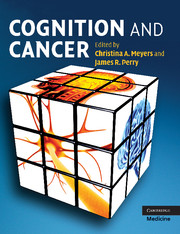Book contents
- Frontmatter
- Contents
- List of contributors
- Preface
- Section 1 Cognition and the brain: measurement, tools, and interpretation
- 1 Introduction
- 2 Clinical neuropsychology
- 3 Brain imaging investigation of chemotherapy-induced neurocognitive changes
- 4 Role of neuropsychological assessment in cancer patients
- 5 Neuropsychological assessment of adults with cancer
- 6 Neuropsychological assessment of children with cancer
- Section 2 Effects of cancer and cancer treatment on cognition
- Section 3 Interventions and implications for clinical trials
- Index
- Plate section
- References
3 - Brain imaging investigation of chemotherapy-induced neurocognitive changes
Published online by Cambridge University Press: 13 August 2009
- Frontmatter
- Contents
- List of contributors
- Preface
- Section 1 Cognition and the brain: measurement, tools, and interpretation
- 1 Introduction
- 2 Clinical neuropsychology
- 3 Brain imaging investigation of chemotherapy-induced neurocognitive changes
- 4 Role of neuropsychological assessment in cancer patients
- 5 Neuropsychological assessment of adults with cancer
- 6 Neuropsychological assessment of children with cancer
- Section 2 Effects of cancer and cancer treatment on cognition
- Section 3 Interventions and implications for clinical trials
- Index
- Plate section
- References
Summary
Introduction
Structural and functional neuroimaging techniques provide a unique opportunity to examine the neural basis for cognitive changes related to cancer and its treatment. While the link between cognitive dysfunction and central nervous system (CNS) cancers (e.g., primary brain tumors, primary CNS lymphoma, brain metastases of cancer in other organ systems, etc.) or non-CNS cancers treated with prophylactic whole-brain radiation seems clear, our understanding of the causes for cognitive changes following chemotherapy for other non-CNS cancers remains much more limited. Research using a variety of neuroimaging modalities has begun to delineate the brain mechanisms for cognitive changes related to cancer and chemotherapy, across a number of cancer subtypes. This chapter will briefly summarize the cognitive domains most likely to be affected following chemotherapy, review the available data relating cognitive performance and structural and functional neuroimaging changes in various cancer populations, and suggest avenues for future work in this area.
As clinical efficacy of cancer treatment has improved survivorship, increased awareness has arisen of issues critical to the functioning and quality of life of cancer survivors. Specifically, cognitive impairment related to cancer and its treatment, including radiation, chemotherapy, and hormone therapies, has been a topic of increasing study for 20 years. While more detailed discussion of cognitive studies of changes in function related to cancer treatment can be found elsewhere in this volume, these issues will be briefly summarized here, as they form a major component from which subsequent neuroimaging research has grown.
- Type
- Chapter
- Information
- Cognition and Cancer , pp. 19 - 32Publisher: Cambridge University PressPrint publication year: 2008
References
- 8
- Cited by



